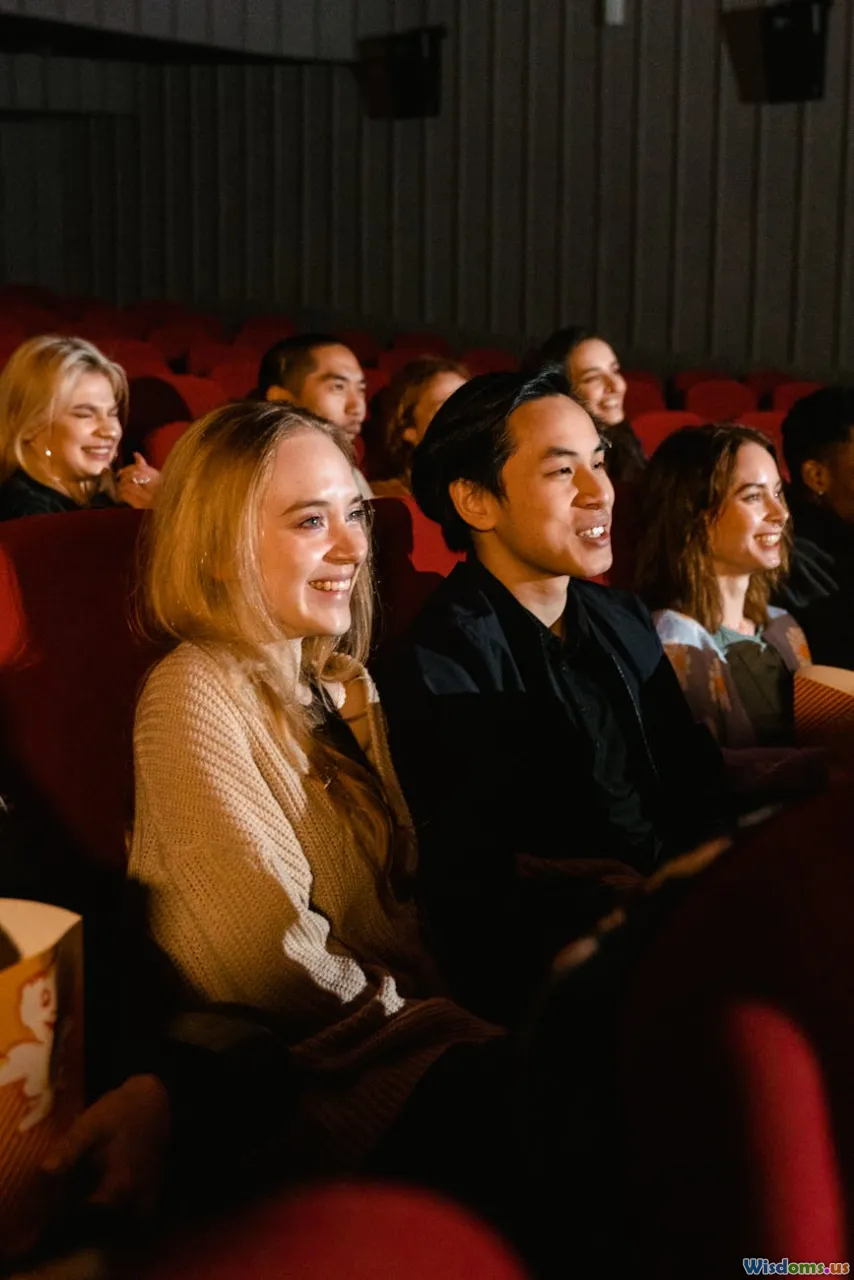
Sleepers to Watch This Awards Season According to Analysts
16 min read Discover under-the-radar films and talent poised for surprise wins during this awards season, spotlighted by top industry analysts. (0 Reviews)
Sleepers to Watch This Awards Season According to Analysts
Awards season is predictably filled with high-profile contenders, familiar faces, and sprawling marketing campaigns. Yet every year, a select few "sleepers"—films and artists who enter the race under the radar—capture the attention of critics, analysts, and sometimes, the voting bodies themselves. These sleeper candidates not only spice up the ceremonies but often make lasting marks on the industry.
In this comprehensive analysis, we’ll explore this year’s most talked-about under-the-radar contenders, what unique qualities set them apart, and why you might want to keep a close eye on these potential breakout names and films.
Charting This Year’s Underdog Films

Not every Oscar winner starts out as a box office giant or festival darling. Many, in fact, begin their campaign journeys as soft buzz, gathering support slowly through passionate word-of-mouth or strategic limited releases. This year, several films fit the classic sleeper mold:
-
“Past Lives” (A24): Celine Song’s directorial debut quietly found its way into critical conversations with its tender storytelling and reflective themes of love, time, and cultural separation. Drawing comparisons to previous sleeper hits like "Moonlight," analysts suspect its emotive resonance will leave a strong impact on voters, particularly in the Original Screenplay and Lead Actress categories.
-
“All of Us Strangers” (Searchlight Pictures): Andrew Haigh’s deeply personal supernatural romance has been earning early festival praise. Though its narrative eccentricity might seem niche, analysts argue its emotional accessibility and Andrew Scott’s nuanced performance could turn critical buzz into Academy recognition.
-
“The Zone of Interest” (A24): Jonathan Glazer’s haunting Holocaust drama premiered to near-universal acclaim at Cannes yet avoided the bombastic hype often associated with Oscar hopefuls. Experts point out its reserved marketing could help set it apart as a true auteur-driven statement.
External signs suggest these films may score surprise nominations, if not outright wins. For example, “Past Lives” was already named Best Film by the Los Angeles Film Critics Association—nearly always a harbinger of awards success.
Indie Studios Breaking Into the Major Leagues

While the major studios pour millions into their frontrunners, the real stories often stem from the independent circuit. Indie studios have embraced bold narratives “mainstream” backers might eschew:
-
A24’s Strategic Diversity: Beyond just “Past Lives,” A24 has managed to land multiple contenders in various categories. Following hits like "Everything Everywhere All At Once," their consistent backing of unconventional scripts is turning industry heads. Data from Variety indicates films with moderate budgets and clever post-festival marketing, as embraced by A24, are increasingly translating into multiple nominations across technical and acting races.
-
Neon’s Genre Surprises: Neon, another indie studio, has fostered “Anatomy of a Fall,” a French courtroom drama that defies genre expectations. It swept top awards at Cannes, and quietly built traction through domestic release—a classic indie awards season tactic.
Analysts note that these studios’ blended strategies of festival acquisition, staggered releasing, and social-media driven publicity often allow for extended buzz, building momentum months into Oscar voting periods.
Breakthrough Performers to Watch

While perennial Oscar nominees command the headlines, it’s often fresh faces who drive the year’s genuine surprises. Among this season’s potential breakthrough artists:
- Da’Vine Joy Randolph in “The Holdovers”: Portraying a grieving cook at a New England prep school, Randolph’s performance has been universally lauded. Awards analysts are noting her presence in key critics’ awards thus far—a crucial driver for further nominations.
- Greta Lee in “Past Lives”: Lee, known for her series work, impresses in the film’s lead role. Her subtle emotional command has made critics flag her as a likely sleeper in Lead Actress conversations.
- Andrew Scott in “All of Us Strangers”: Despite a thorough stage career and acclaimed turns in television, Scott has yet to break through with Academy voters. With praise for his deeply affecting performance, Scott is now an early yet emerging favorite for a nomination.
Industry experts often suggest watching ensemble-heavy films, as such movies frequently create surprising acting slots—like the surge for the cast of “Crash” or “Spotlight” in previous years.
Directors Rewriting the Script

It's not just actors who find themselves propelled forward by unexpected momentum. Directors behind these sleeper films—many helming only their first or second features—are crafting bold, innovative narratives that break the status quo.
-
Celine Song: Her nuanced directorial debut, “Past Lives,” has been instantly compared to Greta Gerwig’s similar leap with “Lady Bird.” Awards analysts recognize when emerging directors bring a fresh, distinct vision that sets their work apart from genre-standard fare.
-
Jonathan Glazer: Widely respected among cinephiles but less so in mainstream Academy circles, Glazer’s choice to focus on the understated horrors of “The Zone of Interest” might be exactly the technical ingenuity the Best Director category is seeking.
Oscar watchers have cited recent changes in Academy membership as enabling wider range in nominated directing talent, allowing relative newcomers and non-English filmmakers better odds at recognition.
Storytelling Innovations Reshaping the Race

One unifying theme among this year’s sleeper contenders is a bold reassessment of traditional storytelling mechanics:
- Nonlinear Narratives: “Past Lives” uses a triptych structure spanning decades, inviting comparisons to last year’s “Aftersun”—also a sleeper that surprised in the Best Actor race.
- Genre-Blending: “All of Us Strangers” melds supernatural and romantic genres for a uniquely affecting result, reminiscent of “Eternal Sunshine of the Spotless Mind.”
- Historical Reinterpretations: “The Zone of Interest” sharply diverges from standard Holocaust film tropes by focusing solely on the domestic life of a Nazi family next to Auschwitz, significantly arresting familiar audience expectations.
Gold Derby—a major awards-focused outlet—regularly tracks how original narrative approaches increase a film’s longevity in Oscar conversations.
The Role of Film Festivals and Critics’ Circles

For many sleepers, the pathway to an Oscar begins not with mass-market previews but with niche audiences and critics. Sundance, Cannes, Toronto, and Venice have long played kingmaker roles for underdog favorites:
- Festival Audience Awards: “Anatomy of a Fall” won the Palme d’Or at Cannes, an honor that has predicted multiple major-category nominations for non-English films in the past (just look at “Parasite”).
- Critics’ List Momentum: Critics’ circles like NYFCC and LA Film Critics are often more adventurous with their picks—and their choices frequently mold frontrunner status. With “Past Lives” earning top early trophies, the ripple effect could be profound.
Insider reports highlight how festivals’ selective programming acts as a prelude to end-of-year campaigns. Films that perform well on the festival circuit tend to secure key distribution deals, meaning they reach voters with the right momentum.
The Power—and Limits—of Social Media

Social media platforms have increasingly tipped the scale for supposed underdog contenders:
- Platforms like X (formerly Twitter) and TikTok allow for rapid dissemination of grassroots buzz. For example, A24’s normative model relies heavily on striking visual campaigns tailored for shareability.
- Hashtags like #OscarsSoIndie trend annually, lifting low-budget releases into the broader cultural consciousness.
That said, social buzz doesn’t guarantee nominations—many critics argue the Academy still skews industry-insider. But widening digital engagement ensures once-obscure films and talents are being considered by more diverse voter bases than ever before.
Statistical Models: How Data Predicts Surprises

Modern awards analysis is more sophisticated than ever. Sites like FiveThirtyEight and Gold Derby aggregate thousands of critical reviews, cast and crew nomination records, and historical voting patterns to craft models on likely outcomes.
For instance, films with high Metacritic scores, a favorable critics-to-audience ratio, and a palpable festival presence statistically outshine bigger budget but critically middling fare. Last year, such models correctly spotted the surprise-slot for “Women Talking,” which had been forecast by climbing sleeper rankings for weeks.
Analysts have flagged this year’s key metrics:
- Critical acclaim across multiple regions
- Acting nominations in early precursor awards
- Social media momentum combined with independent distribution
This triangulation sets up contenders—like “Past Lives” and “All of Us Strangers”—for potential upsets even in crowded categories.
International Films: Rising Beyond Borders

As the Academy diversifies its voting body, international films are making deeper inroads into top categories. This can result in "sleepers" emerging globally:
- “Anatomy of a Fall” (France): With potent storytelling and resonance beyond its borders, it's seen as a potential cross-category disruptor.
- “The Zone of Interest” (UK): Despite being in English, its European provenance marks it as both a regional and thematic outsider.
The 2019 sweep by “Parasite” proved that “Best International Feature” contenders can—and increasingly do—compete credibly for main awards.
What Drives a Sleeper’s Success?

Industry veterans and data scientists alike agree that a mix of timing, critical reception, fresh perspective, and distribution strategy fuels these longshot contenders. When viewers connect emotionally—and when ballot fatigue from viewings of “obvious” choices sets in—voters can be more inclined to circle less hyped but more affecting alternatives.
Oscar ballots now employ a preferential voting system in many categories, which further benefits films with passionate (if not massive) support. When a sleeper consistently appears as a voter’s second or third choice, it creates upward mobility in the nomination process.
To maximize likelihood of an upset or unexpected nomination, analysts offer these tips:
- Track the Critics’ Awards: Films and performers that dominate critic circles accumulate momentum.
- Watch for Festival Reactions: Standing ovations, audience prizes, and fast-acquired distribution hint at sleeper status.
- Assess Online Buzz: Organic, non-marketing-driven social fandom has enabled participants like “Everything Everywhere All At Once” to turn into juggernauts.
- Note Release Strategy: Soft rollouts in select cities followed by critical mass exposure often drive strong word-of-mouth and awards eligibility.
Seasoned voters and observers know that it rarely hurts to look just past the most obvious choices.
Films and performances that deliver unexpected artistic resonance—backed by smart studio campaigning, digital support, and critic enthusiasm—are increasingly rewriting the traditional narrative of awards predictability. As ballots take shape and momentum builds, seasoned analysts know there’s always room onstage for a well-deserving, under-the-radar victory.
This year, keep your eyes on these sleepers. More than ever, the next big moment in cinematic history might come from a place nobody quite expected.
Rate the Post
User Reviews
Other posts in Film & TV Awards
Popular Posts













